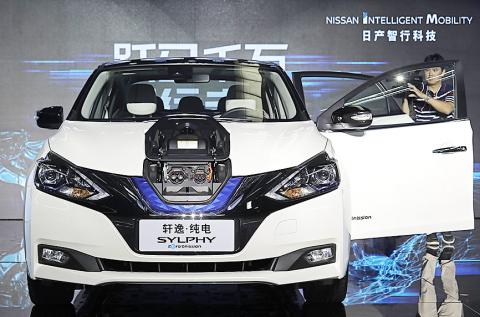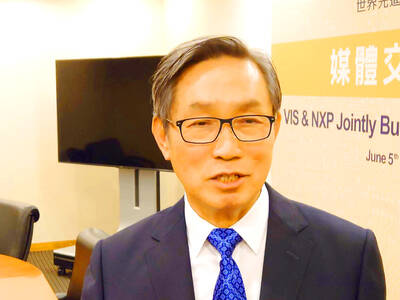Nissan Motor Co’s first electric sedan designed for China yesterday began production at the start of a wave of dozens of planned lower-cost electric vehicles (EVs) being produced by global automakers for their biggest market.
Manufacturers, including General Motors Co (GM) and Volkswagen AG, are this year to launch a flood of electric sedans, minivans and sports utility vehicles in China designed for local tastes and smaller budgets.
Nissan, Tesla Motors Inc, GM and others sell imported electric cars or electrified versions of models made by Chinese partners, but the market is dominated by low-cost local rivals including BYD Co (比亞迪).

Photo: AP
The Chinese government sees electric cars as a promising industry and a way to clean up its smog-choked cities.
It has spent heavily on subsidies to Chinese producers, and is shifting the burden to automakers with sales quotas and tougher fuel efficiency standards.
The Sylphy Zero Emission, based on Nissan’s Leaf, is being produced by Nissan and a Chinese partner, Dongfeng Group (東風集團).
The Sylphy costs 166,000 yuan (US$25,850) after government subsidies, or just more than half the sticker price of the Chinese version of the Leaf sold by Nissan and Dongfeng’s joint venture Venucia brand.
The Sylphy can go 338km on a charge, Nissan has said.
“We’re confident that the Sylphy Zero Emission rolling off the production line today will become a main player in the EV market,” Nissan chief executive officer Hiroto Saikawa said yesterday.
“We’re going to roll out a range of EVs that will appeal to customers within all market segments,” he said.
Sales quotas that are to take effect next year require every brand to sell electric vehicles or buy credits from competitors that do.
That puts pressure on automakers to design models that Chinese want and can afford.
China last year accounted for half of global electric car sales, but almost all of those came from Chinese brands including BYD Auto and BAIC Group (北汽集團).
Their prices start as low as 140,000 yuan.
“Basically, all these international giants are testing the water. They have not really launched their heavyweight models in China yet,” said industry analyst Yale Zhang (張豫) of Automotive Foresight.
“By the end of this year, things will be different,” Zhang said. “We really will see the market become more competitive and consumers will have more to choose.”
Chinese government plans call for total annual sales of 2 million electric and gasoline-electric hybrid vehicles by 2020, up from last year’s 770,000.
GM has said it will roll out 10 electric and hybrid models in China from 2016 to 2020.
By 2025, all its Buick, Cadillac and Chevrolet models in China would offer hybrid or fully electric versions, it said.
Tesla has said that China is its second-largest market.
However, a high sticker price has limited sales by other foreign brands to a few hundred vehicles.

TARIFFS: The global ‘panic atmosphere remains strong,’ and foreign investors have continued to sell their holdings since the start of the year, the Ministry of Finance said The government yesterday authorized the activation of its NT$500 billion (US$15.15 billion) National Stabilization Fund (NSF) to prop up the local stock market after two days of sharp falls in reaction to US President Donald Trump’s new import tariffs. The Ministry of Finance said in a statement after the market close that the steering committee of the fund had been given the go-ahead to intervene in the market to bolster Taiwanese shares in a time of crisis. The fund has been authorized to use its assets “to carry out market stabilization tasks as appropriate to maintain the stability of Taiwan’s

STEEP DECLINE: Yesterday’s drop was the third-steepest in its history, the steepest being Monday’s drop in the wake of the tariff announcement on Wednesday last week Taiwanese stocks continued their heavy sell-off yesterday, as concerns over US tariffs and unwinding of leveraged bets weighed on the market. The benchmark TAIEX plunged 1,068.19 points, or 5.79 percent, to 17,391.76, notching the biggest drop among Asian peers as it hit a 15-month low. The decline came even after the government on late Tuesday authorized the NT$500 billion (US$15.2 billion) National Stabilization Fund (國安基金) to step in to buoy the market amid investors’ worries over tariffs imposed by US President Donald Trump. Yesterday’s decline was the third-steepest in its history, trailing only the declines of 2,065.87 points on Monday and

TARIFF CONCERNS: The chipmaker cited global uncertainty from US tariffs and a weakening economic outlook, but said its Singapore expansion remains on track Vanguard International Semiconductor Corp (世界先進), a foundry service provider specializing in producing power management and display driver chips, yesterday withdrew its full-year revenue projection of moderate growth for this year, as escalating US tariff tensions raised uncertainty and concern about a potential economic recession. The Hsinchu-based chipmaker in February said revenues this year would grow mildly from last year based on improving supply chain inventory levels and market demand. At the time, it also anticipated gradual quarter revenue growth. However, the US’ sweeping tariff policy has upended the industry’s supply chains and weakened economic prospects for the world economy, it said. “Now

An employment discrimination lawsuit against contract chipmaker Taiwan Semiconductor Manufacturing Co (TSMC, 台積電) might soon be expanded after a hearing in a federal court in San Jose, California, on Tuesday to add 15 plaintiffs to the case. According to a court document, the lawsuit, which was refiled in November last year as a form of a class action with 13 plaintiffs in California, wants to add 15 plaintiffs from Arizona, where TSMC is building up its wafer fab capacity. TSMC first committed between 2020 and last year to invest US$65 billion in three advanced wafer fabs in Arizona. It then pledged an